Germans love their goose for Christmas. Traditionally, the
first are slaughtered for St. Martin's day, 11 November. In the weeks leading
up to Christmas, word spread in the village and at the farmer's market that we
had geese for sale − if only four. Though not a traditional Irish Christmas
dish, there were more people interested in getting these rare birds than we
could provide.
This is what you need if you want to pluck a goose: a goose,
buckets of scorching hot but not boiling water to dip the bird in head down,
and some stamina, i.e. not too delicate a nose. I had practiced before in
Germany on one, but to do four was a challenge. Each takes at least 90 minutes
to pluck.
So my trusted housekeeper, Pauline,
put the kettle on to bring the water to a high temperature. On our cooker, an
AGA, that could take an hour. In the meantime, Mac and I chose and caught the
poor first victim straight from the goose hut. When we lifted the roof of the
hut carefully, Father Goose became extremely aggressive, hissing and nipping at
Mac's hands and jeans-clad legs. Their nips hurt! You have to grab the goose by
its neck, which pretty much renders it defenseless. On the yard, near the
compost heap on the wall, we had a timber block for splitting wood for kindling.
Mac carried the goose over there, speaking in soothing tones to it, holding it
with one hand and patting it with his second hand. He then put it on the block.
I held its neck and Mac grabbed the axe. I didn't really dare to watch, but
necessity made me blink and double check that my arm was outstretched far away
enough out of the danger zone. With one swift swing, the goose was in goose
heaven. In contrast to chickens, you can't wring their necks. They are too
strong. But they don't flutter around headless on the yard either as chickens
do.
You have to let the blood drip out
completely before you can proceed. Now the plucking can begin. We had an
enormous double sink that we had bought from a youth hostel and put a big
bucket in both basins. Dip the bird into the hot water and you can pluck away. Pauline
and I stood side by side and worked on a goose each while having a good chin
wag.
Geese are much harder to pluck than chickens because their
feathers are stubborn. Soon the feathers were everywhere! The worst are the pin
feathers. And geese do smell. Raised on a diet of pure grass, it's surprising
how much their intestines stink. After about an hour the feathers were done, and
my hands, legs, and feet had gone cold and numb. At this stage, the city girl
in me chickened out. My hypersensitive nose couldn’t take it anymore. I
volunteered to put the kettle on for a tea break, Elevenses as they call it in Ireland. Pauline was made of tougher material. She didn't mind to
keep going and always looked forward to her hot cuppa. Next she cut up the animals and pulled out the
entrails, a messy and malodorous job. Then she washed them many times with cold water and neatly presented them
on a plate.
Grateful, I had the tea and refreshments ready. Most times we
had to remove little hairs that stubbornly stuck to the skin with tweezers
without tearing the skin. Then one year,
Mac had a brilliant idea: you could actually use a little flame torch
like restaurants use for making Crème Brulée and just singe off the remaining
fine hairs. Again, one had to be careful not to burn or damage the skin.
Our price per animal was about 30 Irish pounds ($50 today),
of which I had to pay Pauline 10 for her work. Every year, I toyed with the
idea of collecting the eiderdown and big feathers to fill pillow cases. The
thought of cleaning these heaps of feathers, however, sounded like too much
work to me. So we never did it. Today I prefer to buy a
goose ready for the oven, if I can find them organically grown: plucked and
cleaned! Thank goodness, my plucking days are over.
Here’s my favorite recipe handed down from my mother: Stuffed
with a mixture of breadcrumbs, apples and onions, the bird requires slow
roasting at 180C/375 F under continuous basting with water, its own juices, and
occasional turning. 2-3 hours is recommended. Delicious accompaniments are
potatoes, red cabbage and apple sauce. Go for a lean bird: geese can be fatty.
Ours never were, because they were grass-fed, free-range--the sporty, muscular
type.
(Excerpt from my upcoming book I once had Farm in Ireland).




























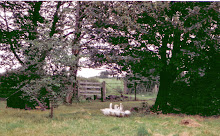




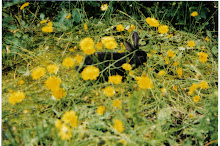








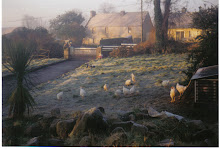
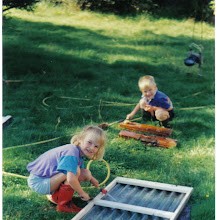











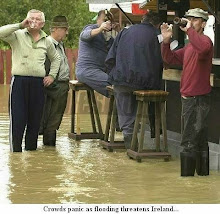


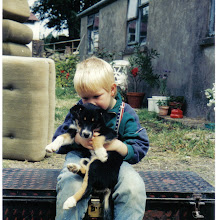


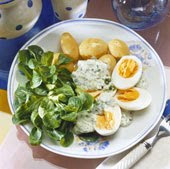
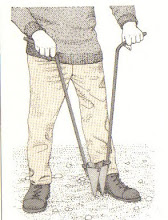
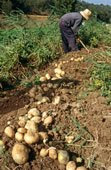

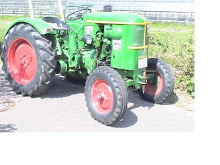






No comments:
Post a Comment